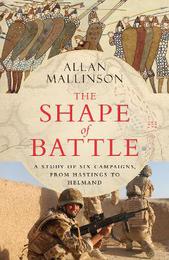
|
The Shape of Battle: Six Campaigns from Hastings to Helmand
Hardback
Main Details
| Title |
The Shape of Battle: Six Campaigns from Hastings to Helmand
|
| Authors and Contributors |
By (author) Allan Mallinson
|
| Physical Properties |
| Format:Hardback | | Pages:416 | | Dimensions(mm): Height 240,Width 162 |
|
| Category/Genre | Military history |
|---|
| ISBN/Barcode |
9781787632417
|
| Classifications | Dewey:355.409 |
|---|
| Audience | |
|---|
|
Publishing Details |
| Publisher |
Transworld Publishers Ltd
|
| Imprint |
Bantam Press
|
| Publication Date |
21 October 2021 |
| Publication Country |
United Kingdom
|
Description
One of our most distinguished military historians tells the story of six defining feats of arms - Hastings, Towton, Waterloo, D-Day, Imjin River and Operation Panther's Claw in Afghanistan - and the wars and campaigns in which they occured, and the factors that determined their precise form and course. One of our most distinguished military historians tells the story of six defining battles . . . Every battle is different. Each takes place in a different context - the war, the campaign, the weapons. However, battles across the centuries, whether fought with sticks and stones or advanced technology, have much in common. Fighting is, after all, an intensely human affair; human nature doesn't change. So why were battles fought as they were? What gave them their shape? Why did they go as they did- victory for one side, defeat for the other? In exploring six significant feats of arms - the war and campaign in which they each occurred, and the factors that determined their precise form and course - The Shape of Battle answers these fundamental questions about the waging of war. Hastings (1066) - everyone knows the date, but not, perhaps, the remarkable strategic background. Towton (1461) - the bloodiest battle to be fought on English soil. Waterloo (1815) - more written about in English than any other but rarely in its true context as the culminating battle in the longest war in 'modern' times. D-Day (1944) - a battle within a larger operation ('Overlord'), and the longest-planned and most complex offensive battle in history. Imjin River (1951) - this little known battle of the Korean War was the British Army's last large-scale defensive battle. Operation Panther's Claw (2009) - a battle that has yet to receive the official distinction of being one- an offensive conducted over six weeks with all the trappings of 21st-century warfare yet whose shape and face at times resembled the Middle Ages. The Shape of Battle is not a polemic, it doesn't try to argue a case. It lets the narratives - the battles - speak for themselves.
Author Biography
A professional solder for thirty-five years, Allan Mallinson began writing while still serving. His first book was a history of four regiments of British light dragoons, one of which he commanded. His debut novel was the bestselling A Close Run Thing, the first in an acclaimed series chronicling the life of a fictitious cavalry officer before and after Waterloo (The Tigress of Mysore is the fourteenth in the series). His The Making of the British Army was shortlisted for a number of prizes, while 1914- Fight the Good Fight won the British Army's 'Book of the Year' Award. Its sequel, Too Important for the Generals, is a provocative look at leadership during the Great War, while Fight to the Finish is a comprehensive history of the First World War, month by month. Allan Mallinson reviews for the Spectator and the TLS and also writes for The Times. He lives on Salisbury Plain.
ReviewsThere is no finer military historian. -- Professor SIMON HEFFER His prose is light and engaging; this is a detailed factual account but it is as pleasurable and easy to read as any well written novel. The maps are excellent, the pace is a brisk canter . . . there are some utterly joyfully arid asides and footnotes that made me laugh aloud . . . this book is simply superb. Buy it. Read it. * ARMY RUMOUR SERVICE (Arrse) * Mallinson writes with an exciting pen and a cool head and he understands war. -- Professor MICHAEL CLARKE It is such a relief to read something by a professional who really knows his stuff. -- Professor SIR MICHAEL HOWARD
|